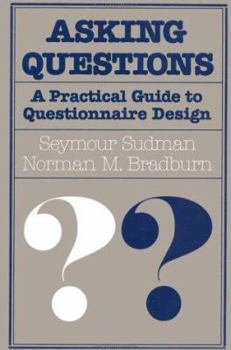Asking Questions: A Practical Guide to Questionnaire Design
Select Format
Select Condition 
Book Overview
Since it was first published more than twenty-five years ago, Asking Questions has become a classic guide for designing questionnaires3/4the most widely used method for collecting information about... This description may be from another edition of this product.
Format:Hardcover
Language:English
ISBN:0875895468
ISBN13:9780875895468
Release Date:November 1982
Publisher:Jossey-Bass
Length:416 Pages
Weight:1.50 lbs.
Dimensions:1.2" x 6.3" x 9.3"
Customer Reviews
5 ratings
Great perspective on questionnaire fundamentals
Published by Thriftbooks.com User , 17 years ago
This edition offers insight about the building blocks of questionnaire development, and more importantly, getting to the right answers. A good focus on the fundamentals and a valuable resource.
The definitive questionnaire design book
Published by Thriftbooks.com User , 17 years ago
This book is a tremendous resource for any social science research methodology course. It should be used as a stand-alone text for a questionnaire design course or as core reading material for a general research methodology class (undergraduate or graduate). As a social scientist, I have used it to successfully create web-based questionnaires that have received great response rates, which I believe are a direct result of the depth and breadth of the knowledge conveyed in the book. In addition, the text itself is easy to understand, interesting, and intellectually stimulating (qualities that are lacking in many other questionnaire design books).
If you ask questions professionally, READ this book!
Published by Thriftbooks.com User , 22 years ago
People tend to see asking questions as an intuitive, conversational means of communication. Wrong. As someone in the professional survey field (SuperSurvey.com), I see a lot of questions every day -- good and bad. Some questions are so poorly written that the responses actually reduce the quality of the survey results.Sudman & Bradburn's book, although originally written for the pre-Internet age, helps people to learn the art and science of writing good questions. The most helpful part of the book is the collection of actual, concrete suggestions for how to word certain types (e.g. threatening/nonthreatening) of questions, mixed with examples of the themes in practice. In addition to designing and wording the actual questions, intelligent strategies for survey instrument design are included. These strategies are mostly pre-Internet, but can be adapted to the constraints and freedoms of Internet surveying.(Surprisingly, though, even today polls and surveys constantly violate the principles in this book. Perhaps a good read alongside _Asking Questions_ would be _How to Lie With Statistics_)._Asking Questions_ lets your surveys and questionnaires benefit from decades of social science and opinion research. Reading it once back in college probably isn't good enough: everyone who does surveys professionally should keep a copy at his desk.
A survey researcher from Missoula, Montana
Published by Thriftbooks.com User , 23 years ago
This book has been an indispendible reference for professional survey researchers since it was written. Asking Questions provides questionnaire writers with extremely useful design guidance and checklists. Most importantly, the book is very easy to read and use. Sudman and Bradburn's status as leading survey methodologists adds to the book's credability. The book is somewhat dated. It's authors were pioneers in the movement to examine the cognitive processes that respondents use to answer questions. Much has been learned since. Unfortunately, due to the recent death of Seymour Sudman, an update of this book is unlikely.The longevity of this book is remarkable and extremely well earned. The guidance it provides is as useful today as it was in 1982.
A good book on survey question design
Published by Thriftbooks.com User , 24 years ago
I was looking for a book on improving survey questions that provided information on reducing bias in survey wording and structure. This book was a great help to me and exceeded my expectations. The book addresses pre-survey issues, specific question-type issues, and survey structure (ordering of questions) issues in a very organized format with plenty of clear examples. The only down-side to the book is that it was written back in '82. I'm wondering if there is a more current version of an equivalent book. I wasn't able to find one.





